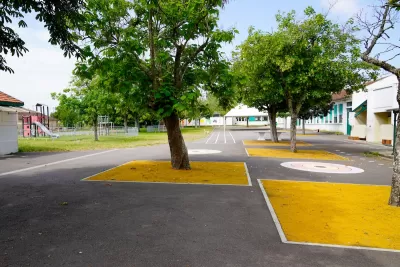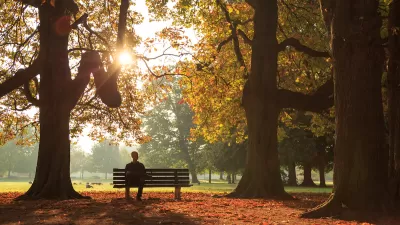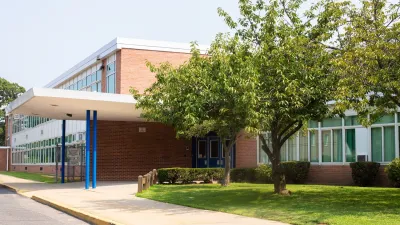More schools are transforming asphalt-covered playgrounds into shady oases that help reduce temperatures and absorb emissions.

In an article for La Voce di New York, Amelia Tricante describes how schools around the country are revamping their schoolyards to include more trees and plants, providing much-needed green space in urban areas.
As Tricante explains, “It isn’t merely about aesthetics; it’s part of a larger push to address the public health risks posed by extreme heat, especially in schools located in urban areas with limited green space.”
Asphalt, which blankets many schoolyards and playgrounds, retains heat and contributes to the urban heat island effect, driving up temperatures on surfaces and in the surrounding air. “Researchers have measured surface temperatures of up to 145 degrees Fahrenheit, putting children at risk of heat-related illnesses and burns. Even alternative surfaces like rubber and artificial turf, which many schools have turned to in recent years, can become unbearably hot.”
But tree planting and landscaping efforts cost money school districts often don’t have. In California, a state bond on November’s ballot could contribute to tree planting initiatives, while Los Angeles has pledged $500 million to schoolyard greening efforts. “In districts where resources are stretched thin, finding a balance between cooling the playgrounds and managing ongoing costs remains a difficult equation.”
FULL STORY: Confronted with Extreme Heat, U.S. Schools Are Greening the Asphalt Jungle

Montreal Mall to Become 6,000 Housing Units
Place Versailles will be transformed into a mixed-use complex over the next 25 years.

Planetizen Federal Action Tracker
A weekly monitor of how Trump’s orders and actions are impacting planners and planning in America.

DARTSpace Platform Streamlines Dallas TOD Application Process
The Dallas transit agency hopes a shorter permitting timeline will boost transit-oriented development around rail stations.

Nine Ways to Use Curb Space That Aren’t Parking
California’s new daylighting law bans parking within 20 feet of crosswalks. How can cities best use this space?

ADUs for Sale? San Diego Could Legalize Backyard Condos
As one of 25 proposed amendments, San Diego may soon allow accessory dwelling units to be bought and sold as individual homes.

Dallas Ditches Parking Minimums in 14-1 Vote
The sweeping city council decision removes set parking requirements from developments downtown, near transit, small businesses and more.
Urban Design for Planners 1: Software Tools
This six-course series explores essential urban design concepts using open source software and equips planners with the tools they need to participate fully in the urban design process.
Planning for Universal Design
Learn the tools for implementing Universal Design in planning regulations.
City of Mt Shasta
City of Camden Redevelopment Agency
City of Astoria
Transportation Research & Education Center (TREC) at Portland State University
City of Camden Redevelopment Agency
Municipality of Princeton (NJ)
Regional Transportation Commission of Southern Nevada





























